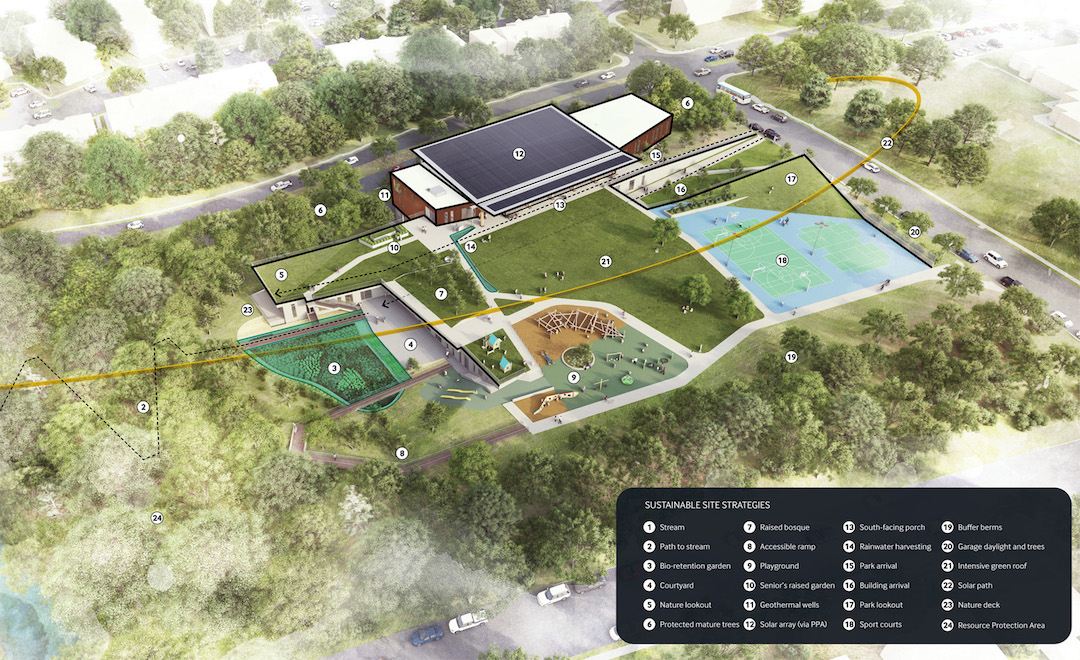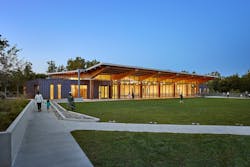Net-zero-energy design enhances multidimensional community center
Honorable Mention
Lubber Run Community Center
Arlington, Va.
Building Team
Submitting firm: MCN Build, Inc. (CM at risk)
Owner: Arlington County, Va.
Architect: VMDO Architects
Structural engineer: Fox + Associates
MEP engineer: CMTA Inc.
Project Information
Project size: 49,000 sf (building); 110,000 sf (including underground parking structure)
Project cost: $41 million
Construction time: August 2018 to July 2020
Delivery method: CM at risk

Judges' Comments
"Great integrtion to the site and park. Use of glulam and wood at the interior further warms up the building and ties to the park's context. The net zero design further reinforces the project's sustainable asirpirations. The project team overcame budget issues by rethinking the parking garage to effectivly reduce cost but not sacrifice scope."
"Value engineering solutions that did not [negatively] impact the program. Design maximizes programming for community in a limited footprint."

Creating a precious new resource
Lubber Run Community Center is located in Lubber Run Park, a precious natural resource in densely urban Arlington, Va., across the Potomac from the District of Columbia. Connection to nature and preservation of open space were essential to designing the new building. For that reason, parking and some programs were intentionally located underground to allow for increased outdoor amenities at the ground level.

The process of designing the center highlights the importance of authentic community engagement. Robust local partnerships supported solutions for a sustainable, place-based design that integrates interior and exterior public and programmed spaces.

Featuring net-zero energy design and a landscape-focused approach to the surrounding park, Lubber Run Community Center offers a holistic response to an urban challenge – ultimately creating public space that is greater and greener for residents.
Lubber Run Community Center replaces a previous 1950’s-era community building on a tight 4½-acre site that also includes new outdoor recreation spaces and amenities. Through the integration of building and landscape, the center offers a zero-energy response to an urban challenge – ultimately creating a shared public amenity that is greater and greener for residents.
Meeting the county's strict environmental agenda
As a LEED for Communities Platinum winner, Arlington County is a sustainability trailblazer, combining forward-thinking environmental goals into its energy-use standards while also balancing issues around livability, diversity, and increasing development.
Building on this commitment to sustainability, Lubber Run Community Center was conceived as a net-zero energy facility. Lubber Run marks Arlington County’s first net-zero energy building, adding to Arlington Public Schools’ three net-zero energy schools that were also designed by VMDO Architects.

Site layout, building massing, envelope design, and systems design were driven by the zero-energy goal of maximizing the on-site solar array while optimizing the building’s energy performance. Using highly efficient MEP systems, along with a unique Thermawall system, increased the project’s energy performance while decreasing the number of materials. Trees that were felled during construction were milled and used to clad the primary circulation pathways inside.
Using value engineering the right way
Early in the project, MCN Build established a Guaranteed Maximum Price, which set the tone for the project’s success. The MCN team ensured that its value engineering solutions were true VEs, not simply cutting scope. Its recommendations resulted in cost savings that did not negatively impact program space while saving money.
Initially, Lubber Run was over budget, but working with Arlington County and VMDO Architects, MCN value reconfigured the original two-story parking garage design into a one-story garage with a larger footprint. The total parking spaces remained the same, but the new design needed less structural concrete, saving more than $5 million.
To maximize the programming within the limited footprint, the park was situated on top of the parking structure. Not only did this require a colossal effort in waterproofing, but it also posed a structural issue. There needed to be enough cushioning between the concrete slab and the ground to “feel” like a park.
However, the amount of soil needed to do this would be too heavy and require a more costly structure to compensate. Instead of removing this feature, the design team used geofoam to prop up with park level. The geofoam was significantly lighter than dirt and allowed for an entire usable park above the parking garage.

Functionality combined with aesthetics
VMDO combined functionality with aesthetic beauty throughout Lubber Run’s design. The design approached maximized the use of required building components, such as the roof drainage system and concrete peelups, by turning them into architectural features.
All buildings require roof drains to prevent a buildup of water. At Lubber Run, the main building has a checkmark shape on the roof. All rainwater on the roof is collected into the “valley” of the checkmark and funneled into a single large drainpipe. This pipe then waterfalls the rainwater into a water channel with river rock that drains into a first flush tank in the garage.
After most particulates are filtered out, it then travels into the irrigation cistern, where the rainwater is used to irrigate the park's lawn. Lubber Run turns a basic building feature such as a roof drain/irrigation system and creates an architectural feature.

Overcoming two major obstacles
The project finished on time and under budget, but there were a few unexpected events. The first was a “storm of the century” that occurred during one of the project’s largest concrete pours in July 2019. A month’s worth of rain deluged the project in an hour. There was fear the structural integrity of the concrete was compromised. MCN ran extensive tests with the structural engineer and was able to salvage the pour and continue with the project.
The second problem that came up during the winter months, as MCN was moving along with interior finishes and using temporary heaters inside the building. Overnight, one of the heaters exploded and damaged the impacted area. No one was injured, but the explosion did hundreds of thousands of dollars’ worth of damage. MCN came up with a recovery plan and did not to lose any time.
Building true community involvement
The process of designing the center highlights the importance of authentic community engagement. Robust local partnerships supported solutions for a sustainable, place-based design that integrates interior and exterior public and programmed spaces.
Together, Arlington Parks & Recreation and VMDO developed a context-specific community engagement process involving a series of transparent public workshops that generated community feedback in an effort to promote equity, access, public health, and sustainable design. The team applied an empathetic approach to gathering cross-generational voices that informed the design of numerous blended spaces connected to nature – spaces inside, outside, and thresholds in between, interweaving building and landscape.

Working through multiple design schemes
Through community meetings, online feedback, and on-site engagement, community voices helped inform the initial stages of design. The first meeting focused on understanding the site and neighborhood, spatial characteristics, and community fears and desires for the project.
Design drivers were derived from this feedback as well as from existing site features, board directives, and sustainability goals. At subsequent meetings, multiple schemes were presented, evaluated and refined, resulting in a hybrid solution that is integrated into the park while still presenting a strong presence in the community
Four schemes provided four options for the community to respond to and consider. Instead of picking one scheme to advance, the goal was to take the best aspects of each scheme and integrate those into a fifth design for further refinement and feedback. The resulting hybrid solution blurs the distinction between indoors and outdoors and encourages occupants to feel connected to the park landscape around them.

Addressing the needs of the community
The 50,000-sf replacement structure includes multipurpose rooms for recreation programs for all ages, a fitness center with locker rooms, a gymnasium, a preschool program, community meeting rooms, a kitchen, and reception and office space for the county's Parks and Recreation staff.

Outdoor programmed and open recreation spaces will include a playground, a volleyball and basketball court, two pickleball courts, covered gathering space, and improvements to site circulation and streetscape needed to facilitate access to the facility by all modes of transportation.
Through the integration of building and landscape, the project offers a holistic response to an urban challenge – ultimately creating public space that is greater and greener for residents.
The community members were involved in multiple meetings with the project team. The team incorporated the feedback and remarks for the community into the design, such as:
- An indoor track above the gymnasium
- Reincorporating a sandpit, a highly requested feature from young families
- Creating an artificial hill to block direct line of sight and sound to neighboring homes
- Adding eight pickleball courts to the design
- Minimizing the number of trees to be demolished. Demolished trees were recycled back into the project as reclaimed wood for finishes
- Providing outdoor ramps that allow access to both levels of the park/building without the use of an elevator to accommodate people with disabilities

